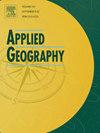二元流视角下区域公共交通连通性对城际交通的动态影响
IF 4
2区 地球科学
Q1 GEOGRAPHY
引用次数: 0
摘要
高速交通和通信技术的进步使城际交通成为推动社会经济发展的关键因素。然而,关于高速铁路(HSR)和航空运输连通性如何影响城际交通的系统分析仍然有限。为了填补这一空白,本文对高铁和航空运输的城际交通影响及其时空异质性进行了实证分析。以2023年节假日和工作日的百度移民和运输服务数据为样本。结果表明,中短途出行在节假日更为突出,而长途出行则以工作日为主。高铁和航空运输对城际交通的影响更多地与改善连通性有关,而不是简单地开放高铁和航空运输。在节假日和工作日,高铁的连通性增加导致城际机动性的增长大于航空运输。高铁和航空交通的互联互通在不同区域、不同距离的城市对中产生了不均衡的城际交通效应。高铁的好处不仅限于中短途,还包括1000-1500公里的长距离。这些启示对高速交通规划提高交通供需之间的适应性具有指导意义。本文章由计算机程序翻译,如有差异,请以英文原文为准。
The dynamic effects of regional public transport connectivity on intercity mobility from a dyadic flow perspective
The advancement of high-speed transport and communication technologies is making intercity mobility a key factor driving socio-economic development. However, systematic analysis of how high-speed rail (HSR) and air transport connectivity impact intercity mobility is still limited. To fill this gap, this paper conducted an empirical analysis of the intercity mobility impact - and its spatiotemporal heterogeneity - of HSR and air transport. Baidu migration and transport services data for holidays and weekdays in 2023 were collected as a sample. The results indicated that short and medium distance travel was more prominent on holidays, while long-distance travel predominated on weekdays. The impact on intercity mobility of HSR and air transport was more related to improving connectivity rather than a simple opening of HSR and air transport. Connectivity increase by HSR resulted in a larger increase in intercity mobility than that of air transport during both holidays and weekdays. HSR and air transport connectivity has generated uneven intercity mobility effects concerning the city-pairs in different regions and distance ranges. The benefits of HSR extend beyond short and medium distances to include longer distances of 1000–1500 km. These implications are useful for high-speed transport planning to improve the adaptability between transport supply and demand.
求助全文
通过发布文献求助,成功后即可免费获取论文全文。
去求助
来源期刊

Applied Geography
GEOGRAPHY-
CiteScore
8.00
自引率
2.00%
发文量
134
期刊介绍:
Applied Geography is a journal devoted to the publication of research which utilizes geographic approaches (human, physical, nature-society and GIScience) to resolve human problems that have a spatial dimension. These problems may be related to the assessment, management and allocation of the world physical and/or human resources. The underlying rationale of the journal is that only through a clear understanding of the relevant societal, physical, and coupled natural-humans systems can we resolve such problems. Papers are invited on any theme involving the application of geographical theory and methodology in the resolution of human problems.
 求助内容:
求助内容: 应助结果提醒方式:
应助结果提醒方式:


